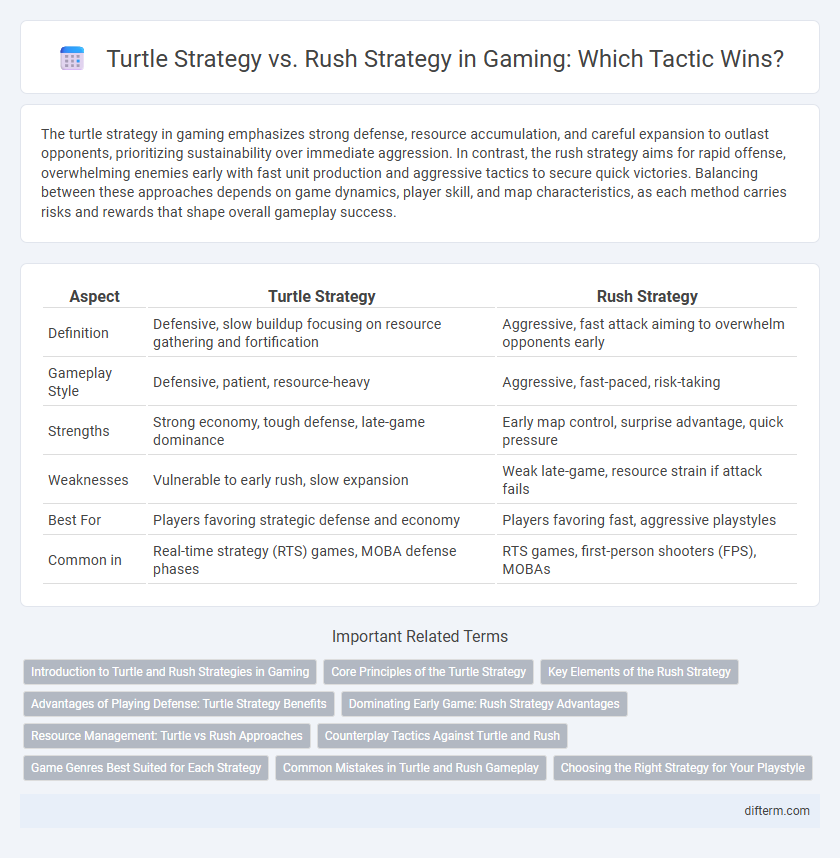The turtle strategy in gaming emphasizes strong defense, resource accumulation, and careful expansion to outlast opponents, prioritizing sustainability over immediate aggression. In contrast, the rush strategy aims for rapid offense, overwhelming enemies early with fast unit production and aggressive tactics to secure quick victories. Balancing between these approaches depends on game dynamics, player skill, and map characteristics, as each method carries risks and rewards that shape overall gameplay success.
Table of Comparison
| Aspect | Turtle Strategy | Rush Strategy |
|---|---|---|
| Definition | Defensive, slow buildup focusing on resource gathering and fortification | Aggressive, fast attack aiming to overwhelm opponents early |
| Gameplay Style | Defensive, patient, resource-heavy | Aggressive, fast-paced, risk-taking |
| Strengths | Strong economy, tough defense, late-game dominance | Early map control, surprise advantage, quick pressure |
| Weaknesses | Vulnerable to early rush, slow expansion | Weak late-game, resource strain if attack fails |
| Best For | Players favoring strategic defense and economy | Players favoring fast, aggressive playstyles |
| Common in | Real-time strategy (RTS) games, MOBA defense phases | RTS games, first-person shooters (FPS), MOBAs |
Introduction to Turtle and Rush Strategies in Gaming
Turtle strategy in gaming emphasizes defensive play, focusing on building strong fortifications and accumulating resources to outlast opponents. Rush strategy prioritizes fast, aggressive attacks aimed at overwhelming enemies before they can establish defenses. Understanding the balance between these tactics is crucial for adapting to different game scenarios and player styles.
Core Principles of the Turtle Strategy
The turtle strategy in gaming emphasizes defense, resource accumulation, and gradual expansion to outlast aggressive opponents. Core principles include building strong fortifications, prioritizing economic development, and maintaining a flexible army for counterattacks. This approach relies on patience and strategic positioning rather than immediate aggression.
Key Elements of the Rush Strategy
Rush strategy in gaming emphasizes rapid early game aggression by deploying units quickly to overwhelm opponents before they can build defenses. Key elements include prioritizing fast resource gathering, minimizing tech upgrades in favor of early unit production, and targeting vulnerable enemy structures to disrupt their economy. Executing a well-timed rush requires precise scouting to identify weak points and maintaining unit momentum to sustain pressure.
Advantages of Playing Defense: Turtle Strategy Benefits
The turtle strategy in gaming provides significant defensive advantages, allowing players to fortify their positions, conserve resources, and build stronger units for sustained control. This approach minimizes early losses and creates a resilient base that withstands aggressive rush attacks. By prioritizing defense, players can exploit opponents' mistakes and gradually gain a strategic upper hand in late-game scenarios.
Dominating Early Game: Rush Strategy Advantages
Rush strategy dominates early game by quickly building offensive units to overwhelm opponents before they can establish defenses. Speed and aggression enable control of key resources and map areas, disrupting enemy economy and expansion plans. Effective rush tactics capitalize on surprise and minimal resource investment for maximum early pressure.
Resource Management: Turtle vs Rush Approaches
Turtle strategy emphasizes long-term resource management by focusing on efficient gathering, stockpiling, and gradual expansion, ensuring sustained defense and economic stability. In contrast, rush strategy allocates resources rapidly into early offensive units and technology to overwhelm opponents quickly, sacrificing resource accumulation for immediate pressure. Effective resource management in turtle gameplay hinges on balance and patience, while rush demands aggressive, front-loaded spending to capitalize on early game momentum.
Counterplay Tactics Against Turtle and Rush
Counterplay tactics against a turtle strategy in gaming involve sustained resource harassment, precise scouting to identify weak points, and targeted strikes on key defensive structures to break fortifications. Against rush strategies, effective countermeasures include early unit production, rapid walling or barricades, and deploying versatile units capable of withstanding initial bursts of aggression. Mastery of these counterplay techniques disrupts opponents' timing and strategy, enabling players to adapt dynamically in competitive matches.
Game Genres Best Suited for Each Strategy
Turtle strategy thrives in real-time strategy (RTS) games like StarCraft and Command & Conquer, where defensive buildup, resource management, and fortification lead to late-game dominance. Rush strategy excels in fast-paced multiplayer online battle arena (MOBA) games such as League of Legends and Dota 2, emphasizing early aggression and quick unit deployment to overwhelm opponents. Turn-based strategy (TBS) games like Civilization balance both approaches, allowing players to adapt turtle or rush tactics depending on the map and opponent behavior.
Common Mistakes in Turtle and Rush Gameplay
Common mistakes in turtle strategy include over-defending, which leads to stagnant resource accumulation and missed opportunities for map control, while rush strategy errors often stem from underestimating enemy defenses and mismanaging early unit production, causing premature attacks and high losses. Players frequently neglect scouting, resulting in poor anticipation of opponent moves and ineffective counterstrategies. Balancing defense and offense with efficient resource management is critical to avoid vulnerabilities inherent in both turtle and rush gameplay.
Choosing the Right Strategy for Your Playstyle
Selecting the optimal strategy in gaming depends on your preferred playstyle and risk tolerance. Turtle strategy suits defensive players who prioritize resource management and long-term growth, while rush strategy appeals to aggressive gamers aiming for quick dominance and early advantage. Understanding your strengths and pacing can determine success by leveraging the turtle's resilience or the rush's speed.
turtle strategy vs rush strategy Infographic

 difterm.com
difterm.com